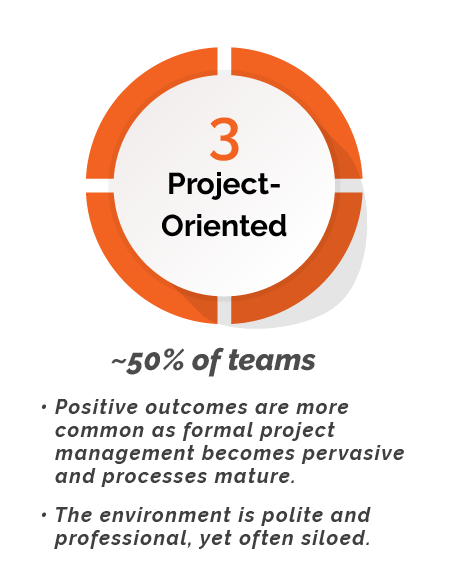Your Team Health and Performance Rating is: “Project-Oriented” and that can be filled with cross-organizational pitfalls.

Project-Oriented Team Characteristics:
-
- Roles / responsibilities are often formalized
- SOPs replace individual checklists
- Project-based outcomes are commonly achieved
- Visibility / integration between projects is limited
- Formal project management is pervasive
- Team members are polite and professional
- Organizational and leadership silos are common
- Employee engagement is average
What does this mean:
Project-Oriented teams value consistency and predictability in work delivery — for individual projects. Without high-level integration across projects, myopia can develop — where the individual project plan (schedule, scope, budget) can overshadow emerging organizational imperatives. In other words, projects can proceed even when their relevance and value come into question.
Moving to the next step:
Teams choose to move to Step 4 (Program-Centered) when they’ve seen the need for more cross-project and organizational integration and collaboration. The team sees the value in a systematic view of work — in terms of quality (overall better outcomes), risk mitigation (we’re better at keeping ourselves out of trouble when we’re working together), and allocation of limited resources (strategy-based ROI).
Ready to take action?
Schedule a brief diagnostic review with Team Tipton:
Learn more about how to improve your team performance and experience:
-
- Strategy-based approach to planning and delivering ROI
- Cross-project integration and collaboration
- Optimized processes and approaches from a big picture perspective
During this 20-minute diagnostic review, Team Tipton will walk through our insights based on your Team Health and Performance Diagnostic results.
We’ll explore possible paths forward and discuss specific ways we can help increase your team’s health and performance through alignment and optimization of the systems, processes, and tools that move teams beyond the courteous, yet often siloed structures and thinking that usually exist in a Project-Oriented work environment.
Healthy companies, we know, dramatically outperform their peers. The proof is strong—the top quartile of publicly traded companies in McKinsey’s Organizational Health Index (OHI) delivers roughly three times the returns to shareholders as those in the bottom quartile. (McKinsey and Co.)

